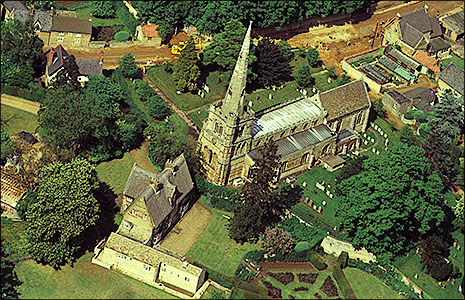| Transcribed from the original article by Douglas Ashby | |||
|
|||
|
|||
An old chronicler records the following:-“There are no tumuli or ancient sepulchral mounds known in Burton. There is, however, some broken ground having the appearance of piled up moats, mounts or trenches adjoining the church on the south west, and the Manor House on the south, and this may have been the site of the Saxon thane’s moated residence.” A piece of carved Saxon stonework was discovered during the restoration of the church in 1864 which probably formed part of a churchyard or village cross, and indicates a much earlier church once stood here. This is supported by the fact that when the church tower was built in the Early English style in 1280, the builders had to cut into the existing Norman church as they were restricted for space due probably to a house of importance already standing on the site of the present Manor House. The south gable of the thatched house has an initialled date stone “Wm I.M. 1704”, although the steep pitch of the roof gives an impression of an earlier period. The thickness of the walls is more than 15² in parts and there are many splendid oak beams. The Manor House belonged to the Montagu family of Boughton and the date stone probably refers to them. It is interesting to note that during this period, Thomas Montagu, grandson of Henry, 1st Earl of Manchester (a cadet branch of the Boughton family) was Rector of Burton Latimer for 42 years from 1676 to his death in 1719 at the age of 68 years (see the memorial on the chancel wall). For many years the property was used merely as a farm house and cattle would be driven along the present footpath through the churchyard into Church Lane. In 1876 the house was sold by the then Duke of Buccleuch to the Rector the Rev F.B. Newman (1872-1895) and on part of the land was built the former Church Day School. For several years the house was a residence of various curates. The Manor House was purchased in the early 1920’s by Mr. Robin Green whose wife was a sister of the Rector, the Rev. L.H. Lethbridge (1920-1930) and it was found necessary to effect structural alterations. The principle change was of the entrance which was moved from the back to the front with a new north gable containing the transposed staircase. During these alterations, the first passage entrance was found beneath the floor of a room used in olden times as a kitchen at the west end of the house. The centre of the floor space caved in to reveal a gaping hole, from which a malodorous gust of air issued. The entrance was quickly sealed up, but not before an old horse shoe lying just under the floor, was picked up. The discovery of a passage entrance on this side of the house lends credence to the story that there is a connecting passage between the Manor House and The Hall some half a mile away across the fields. It is said some time ago up the roadway leading to the former Preston Hall, an arch was discovered not far below the ground surface. This was almost in line between the two houses, but if such a passage extended so far it would have to go rather deeply because of the stream that runs from the ancient fishponds at The Hall. The late Mrs. Charlotte Harpur who died in 1960 aged 94 years, said many attempts had been made at the Hall to discover a passage entrance, but without success. The Hall dates from about 1620 although traces of what is thought was an earlier building were discovered during restoration work about 20 years ago. The other passage entrance was found on the opposite side of the Manor House in the centre of a room which stands only a few yards from the church. Whether this was a connecting link between the house and church, only used by people who had nefarious designs, or whether it was a passage used originally as a means of escape going right away to the Wolds, more or less in the Finedon direction, probably never will be known. The fact remains that there are definitely passage entrances beneath the floors, so the underground paths must lead somewhere. Dr. Robert Sibthorpe (Rector 1629-1644 and 1660-1662) preached a sermon on “the Divine Right of Kings”. Whilst it pleased Charles I who appointed him his Chaplain, it infuriated the Parliamentarians. In 1644 a party of Cromwell’s Roundheads rode into the village and sacked and looted the rectory. Dr. Sibthorpe was forced to flee disguised as his clerk. It is thought he might have used one of the passage to make his escape. The Puritans deprived him of his Living, but on the restoration of Charles II the rector was reinstated in 1660 but only lived 2 more years and is buried in the chancel of the church. A legend is told of a violinist who went down one passage from the Manor House years ago endeavouring to find out all about it. As he walked between the musty, clammy walls, the cold darkness being dimly illuminated by a candle stuck on his cap, he played his instrument. Above, on the earth’s sunlit surface a group of eager Burtonians followed the sounds, stopping now and again to listen more closely to the rise and fall of the subterranean music – until it suddenly ceased – and the violinist was seen no more. From the mid 1930’s and until 1968 Mr. and Mrs. Lancelot Loake owned the property, when the gardens were extended covering the ancient mounds and hollows and became the beautiful grounds they are today. |
|||
